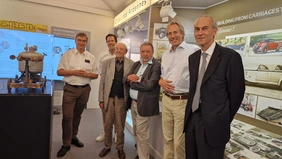The story began in 1671 when the Jesuit monk Ferdinand Verbiest designed a device for the Emperor of China that got moving and stayed moving without outside help. That was a good two hundred years before Carl Friedrich Benz – and just under a century before James Watt.
Verbiest was chief astronomer to the Empire of China and was described by various sources as an engineer of "extraordinary inventiveness and imagination." Historian Dr. Dr. Gerd Treffer, who heads the historical projects department at the Audi Confucius Institute in Ingolstadt, discovered the Belgian missionary Verbiest's invention during research. The vehicle was probably 60 centimeters long, and no one could ride on it. Verbiest's goal was to demonstrate the possibilities of steam power to the emperor.
There are no plans of Verbiest's vehicle, only a description in Latin in a work published at the Jesuit site of Dillingen entitled "Astronomia Europaea". The journal represents a survey of all that was accomplished in the scientific field by the Jesuits in China – and it is, in a sense, a patent specification avant la lettre.
Based on Verbiest's text, students at the THI and the South China University of Technology (SCUT) in Guangzhou, led by Prof. Thomas Suchandt, have reconstructed and rebuilt the first real driving model of the automobile.
First, a feasibility study was prepared for this purpose. Then a prototype vehicle was built using modern materials made of plastic and metal. In this prototype, the historic steam boiler was first replaced by a compressor to generate the necessary pressure. The results were encouraging, as the vehicle was able to run. After that, meticulous work had to be done to research historical mechanics. For example, the deflection from the vertical to the horizontal axis of the wheels could only have been transferred with wooden baskets and comb wheels. This technique had already been known from the water mills.
In September 2021, the replica's maiden voyage was in Ingolstadt; in July 2023, it was handed over to the world-famous Autoworld Museum in Brussels. Other replicas of the vehicle can be seen at the Ingolstadt City Museum, at the THI at "Man in Motion" and at the South China University of Technology in Guangzhou.



![[Translate to English:] Logo Akkreditierungsrat: Systemakkreditiert](/fileadmin/_processed_/2/8/csm_AR-Siegel_Systemakkreditierung_bc4ea3377d.webp)








![[Translate to English:] Logo IHK Ausbildungsbetrieb 2023](/fileadmin/_processed_/6/0/csm_IHK_Ausbildungsbetrieb_digital_2023_6850f47537.webp)


